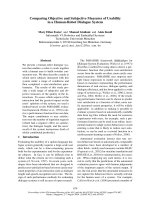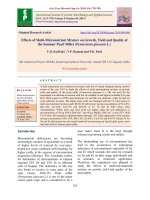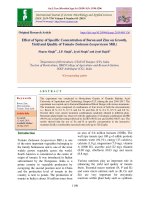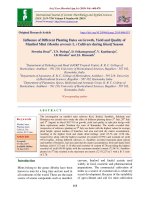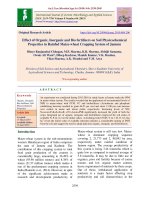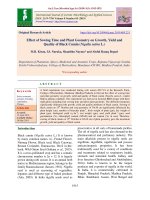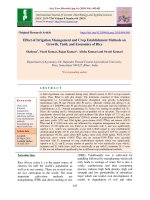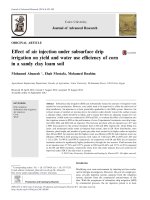Direct and residual effect of sulphur fertilization on growth, yield and quality of mustard in a soybean – Mustard cropping system
Bạn đang xem bản rút gọn của tài liệu. Xem và tải ngay bản đầy đủ của tài liệu tại đây (324.57 KB, 13 trang )
Int.J.Curr.Microbiol.App.Sci (2017) 6(5): 1500-1512
International Journal of Current Microbiology and Applied Sciences
ISSN: 2319-7706 Volume 6 Number 5 (2017) pp. 1500-1512
Journal homepage:
Original Research Article
/>
Direct and Residual Effect of Sulphur Fertilization on Growth, Yield and
Quality of Mustard in a Soybean – Mustard Cropping System
K. Lakshman1,2*, A.K. Vyas1,3, B.G. Shivakumar1,4, D.S. Rana1,
J. Layek1,5 and S. Munda1,6
1
Division of Agronomy, IARI, New Delhi, India -110012
Jute research Station, Katihar-854105, Bihar Agricultural University, Sabour, India
3
ADG(HRM), ICAR, New Delhi-110012
4
IGFRI, Regional Research Station, Dharwad-580005
5
Division of Natural Resource Management, ICAR (NEH Region), India-793103
6
Division of Crop Production, NRRI, Cuttack, India- 753006
2
ABSTRACT
Keywords
Direct effect,
Oil content,
Sulphur levels,
test weight,
Residual effect,
Yield attributes.
Article Info
Accepted:
17 April 2017
Available Online:
10 May 2017
A field experiment was conducted at IARI, Agronomy research farm, New Delhi during
2009-11 for two consecutive years to study the effect of sulphur nutrition on soybeanmustard cropping system (SMCS). The field trial was planned in split plot design to
evaluate the residual effect as main plot representing combination of sulphur levels (0, 15,
30 and 45 kg/ha) and timing of sulphur application (100% at basal, 100% at flowering and
split application as 50% basal + 50% at flowering) applied to preceding soybean crop and
direct effect of S levels (0, 20 and 40kg/ha) applied as a basal to mustard crop as a sub-plot
treatments. Residual effect of sulphur nutrition treatments applied to preceding soybean
crop found non-significant on growth parameters, yield attributes and in quality parameters
like oil content and oil yield of mustard. Where as in direct effect of Sulphur levels (0, 20
& 40 kg/ha) applied to mustard was found significant on growth parameters and yield
attributes. The treatment with 40kg/ha has recorded significantly higher number of
siliquae/plant (204.9), seeds/siliqua (14.47), test weight (5.73g), oil content (38.90%) and
oil yield (711.07 kg/ha) of mustard seed compared to control and 20 kg/ha sulphur
application. This study has demonstrated the importance of sulphur nutrition management
for improving yield of oilseed based cropping system.
Introduction
India is the fifth largest oilseed economy in
the world. Among the seven edible oilseeds
cultivated in India, Rapeseed-mustard
contributes 28.6 per cent in the total oilseeds
production sharing 27.8per cent in the India’s
oilseed economy and ranks third after
soybean and groundnut. India accounts for
about 11.12 per cent (6.8 mt) of global
mustard seed production with an average
productivity of 1115 kg/ha. During the last
seven years, there has been a considerable
increase in productivity from 730 kg/ha in
2006-07 to 1262 kg/ha in 2014-15 however, it
is much below than the global average of
1970 kg/hectare (DRMR, 2015). In 2014-15,
India imported 14.5 million tonnes of edible
oils valued $10.5 billion, included nearly 0.4
million tonnes of imported rapeseed oil,
1500
Int.J.Curr.Microbiol.App.Sci (2017) 6(5): 1500-1512
which many processors and traders are
blending with indigenous mustard oil (ref:
With the country’s
own annual edible oil production stuck at
below 7.5 million tonnes, of which mustard’s
share is roughly a quarter, the need to raise
domestic crop yields and thus cut dependence
on imports cannot be doubted.
In India, mustard is commonly cultivated
during rabi season in most of the cropping
systems viz, Rice-mustard, maize-mustard,
pigeon pea-mustard are common ones. Yield
and quality of mustard is greatly influenced
by the preceding crops in a particular
cropping system. Nutrient exhaustive crops
like rice and maize grown in the preceding
season often reduce the potentiality of the
succeeding mustard while the leguminous
crops have positive influence. In recent years
with the increasing area under soybean
cultivation, the possibility of growing
soybean-mustard in a sequence in many areas
has become an important alternative to
prevailing Rice- wheat cropping system in
Northern plain zone. Vyas et al., (2008)
reported important soybean based cropping
systems practiced in India include soybeanwheat, soybean-chickpea, soybean –potato,
soybean-safflower,
soybean-linseed
and
soybean- mustard. The soybean-mustard is
important cropping sequence in the northern
plain zone, it is having a tremendous potential
for increasing the oilseed production in the
country.
The production constraints of rapeseedmustard crop are diverse in nature. One of the
major constraints is inadequate and
imbalanced nutrient supply. With use of high
analysis fertilizers lacking sulphur and
intensive cropping systems has led to sulphur
deficiency and this is reported from larger
area and variety of crops. Sulphur has several
important functions in plant and it is
important part of every living cell. Sulphur is
required for the formation of chlorophyll and
for the activity of ATP-sulphurylase (the
enzyme involved in sulphur metabolism). It is
involved in several important physiological
functions in mustard including oil synthesis
and act as precursor for synthesis of sulphur
containing amino acids, namely cysteine
(26% S), cystine (27% S) and methionine
(21% S). It is an important constituent of
glucosinolates and is needed for chlorophyll
formation (Holmes, 1980).
Among the oilseed crops, rapeseed-mustard
has the highest requirement of sulphur
(Tandon, 1986). Balanced use of fertilizers
especially sulphur is very crucial for a good
mustard harvest (Aravind et al., 2009).
Application of sulphur increased the yield of
mustard by 12 to 48 per cent under irrigated
and by 17 to 24 per cent under rainfed
conditions (Aulakh and Pasricha, 1988). In
terms of agronomic efficiency, each kilogram
of sulphur increases the yield of mustard by
7.7 kg (Katyal et al., 1997). A significant
increase in yield was observed with increase
in sulphur levels up to 40 kg S/ha in mustard
based cropping system. Keeping all these
points in view, this experiment was
undertaken to study the direct influence of
sulphur levels (0, 20 and 40 kg S/ha) on
mustard vis-à-vis the residual effect of S
nutrition treatments (levels and timing)
applied to preceding soybean crop.
Materials and Methods
A field experiment was conducted for two
consecutive
years
(2009-11),
during
November to April at the agronomy Research
farm of ICAR- Indian Agricultural Research
Institute, New Delhi located at latitude of 280
40"N and 770 12" E longitude at an altitude
of 228.61 m above mean sea level at a new
site each year. The soil of experimental sites
was sandy loam in texture with low in organic
1501
Int.J.Curr.Microbiol.App.Sci (2017) 6(5): 1500-1512
carbon (0.48%) and available N (266.4
kg/ha), medium in available P (8.0 kg/ha) and
K (153 kg/ha) and low in available S (9.5
ppm). The soil was slightly saline in nature
(pH 7.8). The experimental site has a semiarid and sub-tropical climate with hot dry
summers and severe cold winters. The mean
maximum and minimum daily temperatures
were highest at the time of sowing of soybean
in June -July (40 and 24°C) and gradually
decreased to 31 and 15°C respectively during
harvest in September. The temperature drop
to lowest values in January (13.2 and 1.9°C)
during mustard growing season and gradually
reach to 35 and 19°C in April. Mean (56
years) annual rain fall was recorded 769 mm
(January-December), with nearly 85 per cent
of this being received during July to
September and the rest during October to
May. Experiment is conducted in split plot
design, with three replications and the
treatment allocation to experimental plots is
given in table 1.
weeding at 19 and 40 days after sowing was
done. The crop was harvested at physiological
maturity stage.
Land was prepared after harvesting of
preceding soybean crop during October
without disturbing plots. Mustard variety
“Pusa Jai Kisan” was used as test crop and
raised with a seed rate of 5 kg/ha. Crop was
sown by placing the seeds in the furrow
opened with manual drawn plough (kera
method) in rows at 45 cm apart on 17th and 8th
November of 2009 and 2010 and it was
harvested on 26th and 3rd March in 2010 and
2011, respectively. Gap filling was done one
week after germination, wherever necessary.
Thinning was done 15 days after sowing
(DAS) to maintain an intra plant spacing of 5
cm and crop is raised as per the
recommended package of practices with 80
kg N, 60 kg P2O5 and 40 kg K2O/hectare.
Four irrigations were given to mustard crop
during both the years of experimentation.
Weeds were managed through pre-emergence
application of pendimethalin (1 kg a.i/ha
in500 liters of water) and two manual
Number of branches per plant recorded at 60
and 90 DAS (Days after sowing) in all the
treatments were at par with each other except
control in the residual effect of sulphur
nutrition imposed to preceding soybean. Split
Application of 45 kg S/ha (50% basal+50%
flowering) recorded highest number of
branches as compared to treatments received
with lower levels of sulphur (15 and 30kg S
/ha) as a split and sole (either at basal or at
flowering) application of sulphur to the
preceding soybean. Among the direct effect of
sulphur levels (0, 20 and 40 kg/ha) applied to
mustard, treatment with 40 kg S/ha recorded
significantly more number of branches per
plant (7.05) over the treatments with 0 and 20
kg S/ha level (Table 2). Direct application of
sulphur to mustard increased the number of
branches linearly with increased levels of S
application. This is in conformity with the
finding of Chauhan et al., (1996).
Chemical analysis of plant and soil samples
were done using standard procedures (Prasad,
1998).The nutrient (N, P, K and S)
concentration of economic produce and stalks
of mustard were determined and uptake was
measured as product of nutrient concentration
and yield. The analysis of variance (ANOVA)
was done in split-plot design for mustard,
various soil and plant observations were
recorded. The significance of treatment
differences was tested by F (Variance ratio)
test. Critical difference (CD) at 5 per cent
level of significance (P=0.05) was worked out
for comparison and statistical interpretation of
treatments as per Gomez and Gomez (1984).
Results and Discussion
Growth parameters
1502
Int.J.Curr.Microbiol.App.Sci (2017) 6(5): 1500-1512
Dry matter accumulation and LAI (Leaf Area
Index) of mustard was not significantly
influenced by residual effect of sulphur
treatments applied to preceding soybean crop
whereas significant effect was found among
the treatments received with direct application
of sulphur in mustard crop. Among the
treatments imposed to preceding soybean
crop, application of 45 kg S/ha in two splits
(50% basal and 50% at flowering) recorded
highest LAI (0.69, 1.71 and 1.75) and dry
matter accumulation (3.80, 33.04 and 85.29
g/plant) at 30, 60 and 90 DAS respectively.
Direct effect of 40 kg S/ha application to the
mustard recorded significantly higher LAI
(0.69, 1.72 and 1.76) and dry matter
accumulation (3.85, 33.26 and 85.92 g/plant)
of mustard at 30, 60 and 90 DAS respectively,
as compared to the treatments with 0 kg S/ha
and 20 kg S/ha. The LAI was also increased
significantly and linearly with the increasing
levels of sulphur indicating the higher sulphur
demand of mustard. Khanpara et al., (1993)
also reported that increasing level of sulphur
increased LAI in mustard. The drymatter
accumulation is more sensitive to nutrition of
sulphur, indicating low efficiency of mustard
in utilization of residual sulphur. The direct
application of sulphur recorded increased
accumulation of dry matter linearly,
indicating the necessity of additional sulphur
application along with residual effect of
sulphur in field condition. Several researchers
earlier also reported positive effect of sulphur
on dry matter accumulation in mustard
(Khanpara et al., 1993; Singh and
Gangasaran, 1993).
Physiological indices
There was no significant residual effect of S
application on mean Crop Growth Rate
(CGR) recorded between 30-60 DAS and 6090 DAS. However, split application of 45 kg
S/ha as (50% basal and 50% at flowering)
recorded higher value over treatments
received one time application of sulphur
either at basal or flowering stage. Direct
application of S to mustard @ 40 kg/ha
recorded highest mean CGR at different
growth stages, except at 60-90 DAS (Table
3). Whereas, there was no significant residual
effect of S treatments applied to preceding
soybean crop in soybean-mustard cropping
sequence on mean Relative Growth Rate
(RGR) during all the growth stages of
mustard. Small amount of residual sulphur
present at soil may not be sufficient enough to
promote plant growth. Similarly, the mean
relative growth was not observed to be
affected significantly by residual sulphur
applied to preceding soybean. On the
contrary, the increasing sulphur levels applied
to mustard brought about significant increase
in mean CGR in both the years except at 6090 DAS in first. Similar increase in CGR and
RGR due to sulphur application has been
reported by Saha and Mandal (2000). This
may be attributed to positive influence of
sulphur application on various growth
parameters viz. Number of branches, dry
matter accumulation and LAI, these all
ultimately resulted in significantly higher crop
growth rate. There was no significant
interaction effect of sulphur treatments
imposed on preceding soybean and sulphur
treatments provided to mustard. This may be
possibly due to greater demand for sulphur in
mustard and insufficiency of residual sulphur
after the harvest of soybean in soybeanmustard cropping system.
Yield attributes
The number of siliquae per plant, seeds per
siliqua and test weight were not significantly
affected by the sulphur nutrition applied to
preceding soybean crop, whereas treatment
with application of 45 kg S/ha in two splits
(50% basal and 50% at flowering) to
preceding soybean recorded highest number
of siliquae per plant (203.5), seeds/siliqua
1503
Int.J.Curr.Microbiol.App.Sci (2017) 6(5): 1500-1512
(14.20) and test weight of 5.68g (Table 4)
compared to other treatments. This might be
due to the fact that the seed development is
greatly influenced by the sulphur, as mustard
is rich in oil and glucosinolates which are in
turn greatly dependent on the sulphur
nutrition for their formation. The sufficient
residual sulphur might have helped in
increased seed filling leading to higher seeds
per siliqua and development of individual
seeds enhancing the test weight. Among the
sulphur treatments applied to mustard,
application of
40 kg S/ha recorded
significantly highest number of siliqua per
plant (204.9), seeds per siliqua (14.47) and
test weight (5.73g) of mustard compared to
treatment received with 0 and 20 kg S/ha. The
direct application of sulphur in sufficient
quantity and easy availability brought about
significant increase in yield parameters viz.
siliquae/plant, seeds/siliqua and test weight.
Chauhan et al., (1996) was also reported
increase in yield parameters due to sulphur
application in mustard.
Among the sulphur levels applied to mustard,
0, 20 & 40 kg/ha. Application of 40 kg S/ha
to mustard recorded significantly higher seed
yield, stover yield and harvest index over
application of 20 kg S/ha and control. The
positive effect of sulphur nutrition on the
yield levels of mustard have also been
observed by Bhagat and Soni (2000) and
Bharati and Prasad (2003). This could be
attributed to combined effect of increased
availability and higher response of mustard to
sulphur nutrition. As all the growth
parameters starting from plant height, number
of
branches
per
plant,
drymatter
accumulation, leaf area index etc and yield
parameters viz. siliquae per plant, seeds per
plant and test weight were significantly
influenced by the higher levels of sulphur
which culminated in the higher seed yield and
stover yield and also better conversion of
biological yield into economical yield by
significantly higher harvest index.
Oil content and its yield
Seed yield, stover yield and harvest index
Application of 45 kg S/ha in two splits (50%
at basal and 50% at flowering) to preceding
soybean recorded significantly highest seed
yield (1.80t/ha), stover yield (4.5 t/ha) and
harvest index (29.47 %) of mustard (Table 4).
This might be attributed to higher residual
effect of sulphur in that treatment and its
positive influence on the growth parameters
and yield parameter culminating in higher
seed yield. Such residual effects of sulphur
applied in preceding crop on succeeding had
also reported by (Chandel et al., 2003 and
Bharathi and Poongothai, 2008). The sole
application of 45 kg S/ha either at basal or at
flowering also recorded higher values of yield
parameters over the lower levels of sulphur
application, indicating that higher dose of
sulphur to preceding crops led to higher
residual effect and subsequently improved
performance of succeeding crops.
The oil content in seeds and its yield of
mustard was significantly higher with split
application of 45 kg S/ha (50% basal and 50%
at flowering) to preceding soybean. Followed
by 30kg S/ha as a split (50% basal and 50% at
flowering) and 45 kg S/ha at flowering to
preceding soybean. In direct effect, Sulphur
application @ 40 kg /ha to mustard recorded
significantly higher oil content and its yield
(Table 4). The oil content in mustard was
significantly influenced by both the residual
effect of sulphur treatments to preceding
soybean and direct application of sulphur to
mustard. Sulphur plays a very important role
in seed development in mustard as it is an
important component of oil. The increased
availability of sulphur both in the form of
residual sulphur applied to preceding soybean
or directly applied sulphur to mustard
recorded significant increase in the oil content
and its yield.
1504
Int.J.Curr.Microbiol.App.Sci (2017) 6(5): 1500-1512
The oil content in seeds and oil yield recorded
highest with treatments received 45kg S/ha
either as a split or sole application (basal or
flowering) to preceding soybean as compared
to treatments received with lower levels (15,
30kg S/ha). This might be due to higher
quantity of sulphur as residue, which helped
in uptake of sulphur. Tripathi and Sharma
(1993) and Biswas et al., (1995) earlier
reported positive effect of sulphur on oil
content and its yield in mustard under sandy
loam soils of Delhi. The higher demand for
sulphur was further evident from the fact that
the response was linear up to 40 kg S/ha. As
the oil yield is a combined effect of increased
oil content and higher yield, the higher oil
content and seed yield due to application of
45 kg S/ha split as 50% basal and 50% at
flowering to preceding soybean and direct
application of 40 kg S/ha to mustard recorded
significantly higher oil yield. Correlation and
regression between different parameters
showed that there was a positive and
significant correlation existed between yield
attributes (siliqua/plant and seeds/siliqua),
seed yield and oil yield of mustard (Fig. 1).
Uptake by mustard and available N, P, K,
S status in soil after harvest
As the nutrient uptake is a function of
increased nutrient content and biomass
production. In residual effect of S applied to
preceding soybean, the uptake of N, P, K and
S in seed and stover of mustard were higher in
the treatment received with split application
of 45 kg S/ha (50% basal and 50% at
flowering) and in direct effect
treatment
received with 40 kg level of S/ha to mustard
recorded highest values of total nutrient
uptake of N(76.53), P(21.66), K (55.85)&
S(25.74) kg/ha (Table 5). Further as total
uptake is a function of uptake in seed and
stover. Wen et al., (2003) observed the
residual effect of sulphur. This might be due
to better growth parameters and yield
parameters observed in this treatment. This
led to increased absorption of all the plant
nutrients and increased accumulation as
compared to other treatments.
Table.1 Allocation of treatments to soybean and mustard
To preceding soybean (main plot)
To Mustard (sub plot)
T1
Control(No sulphur)
S1
Control(No sulphur)
T2
15kg S/ha basal
S2
20 kg S/ha
T3
30kg S/ha basal
S3
40 kg S/ha
T4
45 kg S/ha basal
T5
15 kg S/ha flowering
T6
30 kg S/ha flowering
T7
45 kg S/ha flowering
T8
15 kg S/ha (50% basal + 50% flowering)
T9
30 kg S/ha (50% basal + 50% flowering)
T10
45 kg S/ha (50% basal + 50% flowering)
1505
Int.J.Curr.Microbiol.App.Sci (2017) 6(5): 1500-1512
Table.2 Number of branches, LAI and dry matter accumulation (g/plant) of mustard at various stages of
crop growth as influenced by treatments (pooled data of two years)
Treatment
Branches/plant
60
90
DAS
DAS
Levels and time of S application to preceding soybean
(kg/ha)
Control (no sulphur)
6.07
9.35
15 kg as basal
6.35
9.97
30 kg as basal
6.66
10.32
45 kg as basal
6.84
10.50
15 kg at flowering
6.56
10.23
30 kg at flowering
6.68
10.43
45 kg at flowering
6.77
10.51
15 kg as split (50% basal + 50% at
6.61
10.06
flowering)
30 kg as split (50% basal + 50% at
6.77
10.25
flowering)
45 kg as split (50% basal + 50% at
6.91
10.51
flowering)
SEm+
0.179
0.234
LSD (P=0.05)
0.51
0.67
Levels of S applied to mustard as basal (kg/ha)
Control
6.16
9.63
20 kg
6.66
10.13
40 kg
7.05
10.88
SEm+
0.096
0.141
LSD (P=0.05)
0.27
0.40
30
DAS
LAI
60
DAS
Dry matter accumulation (g/plant)
90DAS 30 DAS 60
90
At harvest
DAS
DAS
0.60
0.64
0.65
0.67
0.63
0.66
0.67
0.65
1.65
1.67
1.68
1.70
1.67
1.68
1.69
1.68
1.68
1.71
1.73
1.73
1.70
1.72
1.74
1.71
3.36
3.54
3.70
3.80
3.51
3.64
3.74
3.63
30.22
31.02
31.75
32.57
31.06
31.45
32.62
31.43
79.97
81.58
83.87
84.82
82.64
83.12
84.66
83.29
93.68
96.44
97.80
100.29
97.55
97.81
99.80
98.18
0.68
1.70
1.73
3.67
32.56
84.12
98.49
0.69
1.71
1.75
3.80
33.04
85.29
100.86
0.010
0.03
0.015
0.04
0.012
0.04
0.082
0.24
0.394
1.13
0.694
1.99
0.72
2.07
0.61
0.66
0.69
0.003
0.01
1.65
1.69
1.72
0.004
0.01
1.69
1.71
1.76
0.005
0.01
3.40
3.67
3.85
0.050
0.14
30.37
31.69
33.26
0.202
0.57
81.03
83.06
85.92
0.298
0.84
94.61
98.10
101.56
0.35
0.99
1506
Int.J.Curr.Microbiol.App.Sci (2017) 6(5): 1500-1512
Table.3 Physiological indices of mustard at various stages of crop growth as influenced by treatments (pooled data of two years)
Mean CGR(g/day/cm2)
30-60
60-90
90-At
DAS
DAS
harvest
A. Residual effect of sulphur treatments applied to previous crop
Control
0.90
1.66
0.34
15 kg S/ha as basal
0.92
1.69
0.37
30 kg S/ha as basal
0.94
1.74
0.35
45 kg S/ha as basal
0.96
1.74
0.39
15 kg S/ha at flowering
0.92
1.72
0.37
30 kg S/ha at flowering
0.93
1.72
0.37
45 kg S/ha at flowering
0.96
1.73
0.38
15 kg S/ha as 50% basal + 50% at flowering
0.93
1.73
0.37
30 kg S/ha as 50% basal + 50% at flowering
0.96
1.72
0.36
45 kg S/ha as 50% basal + 50% at flowering
0.97
1.74
0.39
SEm+
0.014
0.028
0.020
LSD (P=0.05)
0.04
0.08
0.06
Treatment
Levels of S applied to mustard as basal (kg/ha)
Control
20 kg S/ha
40 kg S/ha
SEm+
LSD (P=0.05)
0.90
0.93
0.98
0.007
0.02
1.69
1.71
1.76
0.012
0.03
1507
0.34
0.38
0.39
0.009
0.03
Mean RGR(g/g/day)
30 -60
60 -90
90-At
DAS
DAS
harvest
0.0734
0.0725
0.0718
0.0716
0.0729
0.0722
0.0723
0.0722
0.0729
0.0723
0.0009
0.0025
0.0324
0.0322
0.0324
0.0319
0.0326
0.0324
0.0319
0.0325
0.0317
0.0317
0.0005
0.0015
0.0052
0.0056
0.0051
0.0056
0.0055
0.0054
0.0055
0.0055
0.0052
0.0056
0.0003
0.0009
0.0733
0.0720
0.0719
0.0005
0.0013
0.0327
0.0321
0.0317
0.0002
0.0007
0.0051
0.0055
0.0056
0.0001
0.0004
Int.J.Curr.Microbiol.App.Sci (2017) 6(5): 1500-1512
Table.4 Yield attributes, Seed yield, stover yield, harvest index, oil % and oil yield of mustard as influenced
by treatments (pooled data of two years)
Treatment
Yield attributes
No of
No
pods/plant seeds/siliqua
Levels and time of application of S to preceding soybean (kg/ha)
Control
195.3
12.97
15 kg S/ha as basal
198.6
13.33
30 kg S/ha as basal
200.0
13.76
45 kg S/ha as basal
202.2
13.77
15 kg S/ha at flowering
198.5
13.74
30 kg S/ha at flowering
201.4
13.94
45 kg S/ha at flowering
203.5
14.06
15 kg S/ha as 50% basal + 50% at flowering
199.5
13.52
30 kg S/ha as 50% basal + 50% at flowering
201.8
14.00
45 kg S/ha as 50% basal + 50% at flowering
203.5
14.20
SEm+
2.14
0.14
LSD (P=0.05)
6.13
0.39
Levels of S applied as a basal to mustard (kg/ha)
Control
196.5
13.14
20 kg S/ha
200.0
13.57
40 kg S/ha
204.9
14.47
SEm+
0.78
0.02
LSD (P=0.05)
2.20
0.05
1508
Test
wt
(g)
Seed
yield
(t/ha)
Stover yield
(t/ha)
Harvest
index
(%)
Oil
(%)
Oil
yield
(kg/ha)
5.26
5.35
5.47
5.63
5.38
5.53
5.64
5.60
5.66
5.68
0.05
0.15
1.58
1.66
1.70
1.77
1.63
1.70
1.78
1.68
1.77
1.80
0.017
0.05
4.29
4.43
4.44
4.50
4.43
4.45
4.48
4.42
4.47
4.50
0.047
0.14
27.15
27.84
28.21
29.12
27.65
28.65
29.40
28.17
29.29
29.47
0.353
1.01
36.94
37.78
37.89
38.50
38.00
38.33
38.54
38.35
38.73
39.19
0.088
0.25
584.31
626.48
643.34
684.00
620.98
653.43
684.80
642.66
687.52
706.73
6.283
18.02
5.28
5.55
5.73
0.02
0.07
1.59
1.70
1.83
0.005
0.01
4.34
4.43
4.55
0.011
0.03
27.44
28.45
29.59
0.081
0.23
37.60
38.18
38.90
0.040
0.11
599.06
650.15
711.07
1.908
5.37
Int.J.Curr.Microbiol.App.Sci (2017) 6(5): 1500-1512
Table.5 Total uptake by mustard and available status of nitrogen, phosphorus, potassium and sulphur after harvest
as influenced by treatments (pooled data of two years)
Total uptake
N
P
K
Treatment
(kg/ha) (kg /ha) (kg/ha)
Levels and time of application of S to preceding soybean (kg/ha)
Control
63.73
17.28
50.46
15 kg S/ha as basal
66.23
18.43
51.85
30 kg S/ha as basal
68.24
19.22
52.99
45 kg S/ha as basal
71.36
20.66
54.71
15 kg S/ha at flowering
67.85
18.36
52.63
30 kg S/ha at flowering
71.77
20.08
53.71
45 kg S/ha at flowering
72.62
20.85
54.56
15 kg S/ha as 50% basal+ 50% at flowering
70.87
19.40
53.41
30 kg S/ha as 50% basal+ 50% at flowering
73.93
20.84
54.38
45 kg S/ha as 50% basal + 50% at flowering
76.32
21.92
55.91
SEm+
0.634
0.359
0.719
LSD (P=0.05)
1.82
1.03
2.06
Levels of S applied as a basal to mustard (kg/ha)
Control
63.96
17.68
51.00
20 kg S/ha
70.49
19.77
53.53
40 kg S/ha
76.43
21.66
55.85
SEm+
0.182
0.080
0.113
LSD (P=0.05)
0.51
0.22
0.32
1509
S
(kg/ha)
Available nutrient status
P
K
S
N (kg/ha)
(kg/ha)
(kg/ha)
(kg/ha )
20.82
21.86
23.14
24.43
22.97
24.75
24.93
23.73
24.66
26.23
0.365
1.05
206.16
197.78
191.77
184.90
197.27
196.64
191.33
193.49
190.76
186.35
1.547
4.44
14.66
13.90
12.79
13.42
14.37
13.56
12.55
13.68
12.64
12.09
0.786
NS
165.88
160.96
156.05
150.12
158.59
151.17
145.40
148.97
141.86
139.12
2.101
6.02
8.67
9.67
9.80
9.89
9.62
9.89
10.21
9.95
10.12
10.18
0.032
0.09
21.73
23.79
25.74
0.091
0.26
201.33
193.10
186.51
0.100
0.28
15.29
13.11
11.70
0.116
0.33
160.13
151.17
144.13
0.161
0.45
9.50
9.79
10.11
0.010
0.03
Int.J.Curr.Microbiol.App.Sci (2017) 6(5): 1500-1512
Fig.1 Relation between yield attributes with seed and oil yield
Further the direct application of sulphur to
mustard, recorded highest N, P, K and S
contents in seed and stover. This might be
attributed to overall improved growth leading
to higher absorption of nutrients due to
complementary effect of sulphur on other
nutrients like N, P and K. The increased
availability of sulphur due to these treatments
led to increased accumulation.
In residual effect the highest available
nutrient status(kg/ha) of N(206.16), P(14.66)
and K(165.88) in the soil after the harvest of
mustard was recorded with no sulphur
application to preceding soybean where as
highest available S(25.74) in soil
was
recorded in treatment received with
application of 45 kg S/ha as a split (50% basal
and 50% flowering) to preceding soybean
(Table 5). The lowest available N, P, K. status
in soil was recorded with application of 45 kg
S/ha split as 50% basal and 50% at flowering
to preceding soybean and lowest available S
was observed with no application of S to
preceding soybean. In direct effect of sulphur
levels applied to mustard, the application of
no sulphur to mustard recorded higher
available N, P and K status after the harvest
of mustard, while the highest available S was
recorded with application of 40 kg S/ha.
Conversely, the lowest available N, P and K
in soil was with application of 40 kg S/ha and
lowest available S was with no application of
sulphur to mustard in both the years of
experimentation.
In conclusion, based on 2 years study, It is
concluded that the residual effect of sulphur
nutrition treatments on yield attributes, yield
and quality of mustard were only seen in
1510
Int.J.Curr.Microbiol.App.Sci (2017) 6(5): 1500-1512
treatments received with application of
sulphur in two splits at (50% basal and 50%
flowering) compared to treatments received
with sole application of sulphur either as a
basal or at flowering only. Direct effect of
sulphur application to mustard crop was
found to be more effective than the residual
effect of sulphur applied to previous soybean
crop in soybean-mustard cropping sequence.
Among the three levels of sulphur (0, 20 and
40 kg S/ha) applied to mustard, the treatment
with 40 kg sulphur level of application to
mustard recorded higher growth and yield of
mustard, showing in mustard crop the
response to applied sulphur is up to level of
40 kg /ha application.
References
Aravind Kumar, Pankaj Sharma, Lijo
Thomas, Abha Agnihotri and Banga,
S.S. 2009. Canola cultivation in India:
scenario and future strategy. 16th
Australian Research Assembly on
Brassicas, Ballarat Victoria, Australia.
Aulakh, M.S. and Pasricha, N.S. 1988.
Sulphur fertilization of oilseeds for
yield and quality. TSI-FAI symposium,
Sulphur in Indian Agriculture-S-11/3.
Bhagat, K.L. and Soni, K.C. 2000. Effect of
nitrogen and sulphur on growth, seed
and oil yield of mustard (Brassica
juncea). J. Oilseeds Res., 17(1): 96-99.
Bharathi, C. and Poongothai, S. 2008. Direct
and residual effect of Sulphur on
growth, nutrient uptake, yield and its
use efficiency in Maize and subsequent
Green gram. Res. J. Agri. Biol. Sci.,
4(5): 368-372.
Biswas, D.R., Ali, S.A. and Khera, M.S.
1995. Response of Ghobi Sarson
(Brassica napus L. ASN–706) to
nitrogen and sulphur. J. Indian Soc. Soil
Sci., 43: 220.
Chandel, R.S., Singh Kalyan, Singh, A.K. and
Sudhakar, P.C. 2003. Effect of sulphur
nutrition in rice (Oryza sativa L.) and
mustard (Brassica juncea L. Czern and
Coss.) grown in sequence. Indian J.
Plant Physiol., 8(2):155-159.
Chauhan, D.R., Paroda, S. and Ram, M. 1996.
Response of Indian mustard to
biofertilizers, sulphur and nitrogen
fertilization. Indian J. Agron., 41(4):
600-603.
DRMR. 2015. Annual Progress Report of All
India Coordinated Research Project on
Rapeseed-Mustard pp. A1-22..
Gangasaran and Giri, G. 1986. Growth and
yield of mustard as influenced by
irrigation and
plant population.
Annals of Agri. Res., 7(1): 68-74.
Gomez, K.A. and Gomez, A.A. 1984.
Statistical Procedures for Agricultural
Research. 2nd Edition, John Wiley and
Sons, New York.
Katyal, J.C., Sharma, K.L. and Srinivas, K.
1997. S in Indian Agriculture, pp.KS2/1-2/12.
Khanpara, V.D., Porwal, B.L., Sahu, M.P. and
Patel, J.C. 1993. Effect of nitrogen and
sulphur on growth and yield of mustard
(Brassica. juncea). Indian J. Agron.,
38(2): 266-269.
Saha, A. and Mandal, B.K. 2000. Growth and
yield of yellow sarson and mustard in
relation
to sulphur nitrogen in
lowland entisol under rainfed condition.
J. Oilseeds Res., 17(2): 307-314.
Sharma, R.S., Agrawal, K.K. and Jain, K.K.
1994. Influence of spatial arrangement
and nitrogen levels on light utilization
and productivity in maize-soybean
intercropping system. J. Oilseeds Res.,
11(2): 217-221.
Shekhawat, K., Rathore, S.S., Premi, O.P.,
Kandpal, B.K. and Chauhan, J.S. 2012.
Advances in Agronomic Management
of Indian Mustard (Brassica juncea (L.)
Czernj. Cosson): An Overview. Int. J.
Agron., 1-14.
Tandon, H.L.S. 1986. Sulphur Research and
Agricultural Production in India.
1511
Int.J.Curr.Microbiol.App.Sci (2017) 6(5): 1500-1512
Second Edition. Fertilizer Development
and Consultation Organization, New
Delhi, pp-160.
Tripathi, P.N. and Sharma, N.L. 1995. Effect
of gypsum and pyrites on yield and
quality of mustard in salt affected soils
of Western U.P. J. Indian Soc. Soil Sci.,
43(2): 290-291.
Vision 2050.DRMR. 2015. Directorate of Rap
eseed and Mustard, Sewar, Bharatpur, R
ajasthan.
/>Vyas, A.K., Billore, S.D., Chauhan, G.S. and
Pandya, N. 2008. Agro-economic
analysis of soybean –based cropping
systems. Indian J. Fertilizers, 4(5): 4154.
How to cite this article:
Lakshman, K., A.K. Vyas, B.G. Shivakumar, D.S. Rana, J. Layek and Munda, S. 2017. Direct
and Residual Effect of Sulphur Fertilization on Growth, Yield and Quality of Mustard in a
Soybean – Mustard Cropping System. Int.J.Curr.Microbiol.App.Sci. 6(5): 1500-1512.
doi: />
1512
